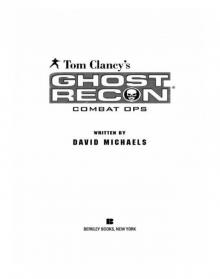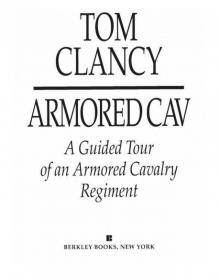- Home
- Tom Clancy
Airborne: A Guided Tour of an Airborne Task Force Page 4
Airborne: A Guided Tour of an Airborne Task Force Read online
Page 4
A McDonnell Douglas C-17A Globemaster III in flight. Hugely expensive, this is the most capable airlift aircraft ever built.
OFFICIAL U.S. AIR FORCE
PHOTO VIA McDONNELL
DOUGLAS AERONAUTICAL
SYSTEMS
One other aspect of deploying personnel and equipment by air that we also need to consider is airborne refueling. Ever since a group of Army Air Corps daredevils (including Carl “Tooey” Spatz and several other future Air Force leaders) managed to stay aloft for a number of days by passing a fuel hose from one aircraft to another, aerial refueling has been a factor in air operations. Air-to-air refueling came into its own over Vietnam, where it became a cornerstone of daily operations for aircraft bombing the North. Later on, in the 1970s, in-flight refueling of C-5s and C-141s became common. This was especially true during the October 1973 Arab-Israeli War, when a number of European countries would not allow U.S. cargo aircraft to land and refuel. This meant that tankers based along the way had to refuel the big cargo jets so that they would be able to make their deliveries of cargo into Ben-Gurion Airport nonstop. Today, Air Force cargo flights utilizing air-to-air refueling are commonplace, but then it was cause to rethink the whole problem of worldwide deployment of U.S. forces.
For much of the past thirty years, the bulk of the USAF in-flight refueling duties has been handled by the KC-135. But while highly capable, the -135 has one problem. It can either give away fuel, or deploy to an overseas theater, but not both at the same time. Given the need of airborne tanker aircraft to support intercontinental deployments by U.S. forces and still get there themselves, the USAF envisioned a new kind of refueler in the late 1970s. While based on a commercial airliner, the new tanker would be capable of carrying a much larger fuel load than the aging -135s. In addition, a heavy load of palletized cargo and personnel would be carried, to assist USAF units in deploying to bases overseas. Finally, it would be capable of itself being tanked in flight, as well as being able to refuel other aircraft from either the USAF “flying boom” system, or the more common U.S. Navy/NATO “drogue and probe.” The result was the McDonnell Douglas KC-10 Extender, of which sixty were bought in the 1980s. Today, the surviving fifty-nine KC-10s are the crown jewels of the Air Mobility Command’s tanker fleet. Closely held and lovingly maintained, they may be the key to successfully deploying our forces into remote overseas locations in the future. However you view the tanker force, though, it is important to remember that U.S. forces will go nowhere without a well-prepared and adequately equipped force of airlift/tanker aircraft and qualified crews.
A McDonnell Douglas KC-10A extender aerial tanker aircraft preparing to refuel another KC-10. These aircraft are the key to Intercontinental deployments by the U.S. Armed Forces.
OFFICIAL U.S. AIR FORCE
PHOTO VIA McDONNELL
DOUGLAS AERONAUTICAL
SYSTEMS
By this time you may well be asking about the worth of building a huge fleet of transport aircraft in an era of trillion-dollar federal deficits and our own pressing domestic needs. More than a few Americans wonder about the need for the United States to have forces capable of intervention overseas. While valid questions, they fail to take into account the reality of America’s place in the world. Whether we like it or not, the U.S. has responsibilities; airpower, including the AMC fleet of tanker and transport aircraft, frequently makes up our first response to the events in that world. Several years ago, when Colonel John Warden was interviewed for Fighter Wing, he said that “every bomb is a political bomb with political effects and consequences.” You could easily say the same thing about sorties by transport aircraft. While one mission may have you dropping paratroopers on a local warlord, another may see relief supplies being flown to refugees or disaster victims. Thus, like bombers and fighters, transport aircraft are just as much instruments of airpower as the more obvious combat types. In fact, because they can provide service in both combat and peacetime mission, they are perhaps even more powerful than their armed brethren. That is something to consider in these days of force reductions and expanding military missions.
Parachutes
When you look up at a parachute, it seems an absurdly simple concept. Yet, a parachute is as much an aerodynamic design as a stealth fighter. It lives and operates by the same physical laws in the same environment, and can suffer the same consequences in the event that those laws are violated. The idea of the parachute is hardly new. In the craft of the sailmaker, we can see that men had mastered the art of making strong and light fabric structures centuries ago. Thus, it is amazing that even today, such a simple idea as the parachute is at the core of technologies that make airborne warfare possible now and into the 21 st century. Nevertheless, the first man to imagine a parachute was apparently that prolific Italian genius Leonardo da Vinci (1452-1519). In a manuscript dated about 1480, there is a sketch of a man dangling from a pyramid-shaped structure. An enigmatic caption says:
... if a man has a tent of linen, with all the openings sealed up, he will be able to throw himself down from a great height without injury....
The canopy depicted in da Vinci’s drawing is too small, and the shape would have made it terribly unstable, but it might have worked. There is no evidence Leonardo ever tested his device, or even experimented with models. In spite of this, the basic concept was on the proverbial drawing board, just waiting for someone to do something with it.
Much of the technology that eventually led to the development of modern parachutes is derived from the construction of balloons. Early on, much balloon activity was centered in France. Benjamin Franklin (1706-1790) observed some of these flights while American ambassador to France, and quickly grasped the military implications of the new technology. From his observations of these flights came the quote at the beginning of this chapter. Ballooning never did emerge as a serious military force, but did encourage the development of the parachute. First as a daredevil spectacle, and later as a practical safety measure. Interestingly, prior to the first flights by heavier-than-air craft in the early 1900s, manned parachute jumps were being regularly made from moored balloons. The earliest military parachutists were balloon observers on both sides of the Western Front during World War I. These artillery spotters, in wicker baskets dangling from flammable hydrogen balloons, were terribly vulnerable to machine-gun fire from roving enemy aircraft. So the observers were equipped with crude parachutes and trained to bail out whenever an attack was threatened.
Despite parachutes being well developed and fairly reliable, few tactical aviators of the Great War ever used them. Early pursuit (fighter) aircraft of the day simply did not have the necessary lift to carry a man, the machine itself, guns, ammunition, a parachute, and other safety equipment. By 1918, though, the German Air Force had realized that parachutes could save the lives of irreplaceable and scarce veteran pilots, and began to issue them. None of the Allied air forces ever gave parachutes to tactical aviators.
A conceptual view of Leonardo da Vinci’s parachute design.
OFFICIAL U.S. ARMY PHOTO
The inter-war years were a time of slow and quiet development in parachute technology. By the opening of World War II, the state of the art in parachute development was based upon the labor of the industrious silkworm. This may seem odd in light of the then-recent development (in the 1930s) of such synthetic fibers as nylon by the DuPont Corporation. However, the first applications of nylon were limited to making household items like toothbrushes and women’s stockings. Thus, the many potential benefits of synthetic fibers to airborne warfare were to be denied until after World War II. Virtually every parachute used by airmen and paratroopers in that war was made from that most comfortable of fabrics: silk. Silk has many desirable qualities when used in parachutes. These include light weight, an extremely dense thread count (the number of fibers per inch when woven), a favorable porosity to air, and great tensile strength when woven into fabric and lines. Given a careful cycle of packing and cleaning, the Wo
rld War II-era parachute could be used several dozen times with confidence.
The personnel parachutes used in World War II by most nations were fairly similar in design. Most utilized a circular canopy or shroud of woven silk cloth. Around the base of the canopy was a fabric support base called a skirt, from which the support or shroud lines hung. Usually the paratrooper would be held by a special harness, designed to spread the shock and loads of the parachute opening over the body. The harness was attached to a set of thick fabric supports called risers, which fed up to shroud lines.
The basic design of most non-steerable parachutes has changed little over the last six decades. A circular canopy chute will, once inflated, essentially fall in a straight and vertical line. Notwithstanding the effects of cross-winds, this means that if a stick (or line) of paratroops is dropped at regular intervals behind an aircraft, they will be spaced fairly evenly as they descend. Using circular parachutes also minimizes the chances of a midair collision between two or more paratroopers trying to maneuver. This is the reason why today, in an era when sport parachutists (“sky divers”) almost always use square parafoil parachutes which are steerable, the older-design circular models are always used in mass airdrops.
When packed, the parachute is attached to a tray which is mounted on the back of the paratrooper and attached to the harness. Around the tray are a series of overlapping fabric panels, which form a protective bag to keep the chute from being snagged or damaged prior to opening. When folded over, the bag flaps are secured with rubber bands and light cords (much like shoestrings). These are designed to break or fall away when the parachute is deployed, and must be replaced prior to each jump. As for the parachute itself, the actual deployment is handled by a long cord (called a static line) attached to the drop aircraft. When the jumpers exit the door of the airplane, they fall a set distance, and then the static line yanks the parachute loose from the bag, starting the deployment cycle. Use of the static line also has the advantage of taking the task of parachute deployment out of the hands of what probably is an overloaded, frightened, and potentially forgetful paratrooper. Should the back-mounted parachute (called the “main”) fail to deploy properly, the jumper can usually make use of a chest-mounted backup chute. The backup parachutes are manually deployed, and represent a second (and final!) chance should the main fail to open properly. By the middle of World War II, most nations deploying paratroopers had such equipment.
There were some differences in the parachutes used by various nations during World War II. For example, the German RZ-16/20 utilized a suspended harness arrangement, which allowed a Fallschirmjäger to fire his weapon while descending, but placed a premium on the athletic skills of the operator to avoid injury during parachute deployment and landing. By contrast, the American T-series chutes were utterly conventional, and have been little changed in today’s T-10 models. For their time, though, the early T-series chutes were fairly reliable, with good sink rates (how fast you lose altitude and hit the ground!) and maximum payloads. However, the use of parachutes to deliver loads like personnel and light cargo containers represented the upper limit of what could be achieved using natural fabrics. This meant that other means had to be developed so that heavy weapons and equipment could be delivered with airborne troops. In fact, the development of cargo gliders was the beginning of what we now call “heavy drop.” This is because higher loads would cause the natural fibers of the day to rip, tear, or break, causing the parachute to fail. Synthetic fibers would have been tougher and thus capable of handling larger loads, but their use was some years off.
The cargo gliders of the Second World War were designed to move personnel and heavier equipment like jeeps, antitank and field guns, and headquarters gear. Early on, the German airborne forces led the world in the development of specialized equipment for delivery of combat gear by air. The Germans started with the small DFS 230, which could carry ten men or a 900-kg/1,984-1b cargo load. Later, they produced the Go 242 medium glider and the huge Me 321, which could carry loads up to a light tank. The British produced similar craft, with their own Horsa medium glider and the big Hamilcar, which could carry a small Locust light tank. American efforts were somewhat more limited than the Germans and British, producing the Waco medium glider, with a similar load to the Horsa. Gliders, however, were dangerous and unreliable. Lightly built, they sometimes would break up while being towed to their landing zones. Even more likely was a dangerous crash upon landing, which could kill the crew and passengers, or destroy the cargo load. But until the development of really large synthetic cargo parachutes in the 1950s, gliders were the only way to land really big loads into a drop zone.
All that changed during the postwar period. Paratroopers were relieved to see the development of larger purpose-designed transport aircraft like the Flying Boxcars, and parachutes large enough to be able to land the largest loads they might need. These large cargo chutes made unmanned delivery of cargo and equipment both possible, and much more reliable than gliders of World War II. The key to the new cargo parachute designs was the use of synthetic fibers as the load-bearing material. The larger cargo parachutes changed the face of airborne warfare. Rather than the vulnerable gliders having to follow the paratroopers into a “hot” DZ, the heavy cargo could now be dropped just minutes ahead of the troopers. This improved the chances of achieving tactical surprise in a drop operation as well as insuring that more of the airborne’s vital equipment and supplies arrived intact. As an added bonus, the new materials, synthetics like nylon and rayon, were also used in the new generation of personnel parachutes, making them much more reliable with a much longer service life. Up to a hundred jumps can be made on a single modern synthetic T-10 parachute, which makes it quite a bargain by current defense standards.
By the 1960s, several new ideas in parachute design were beginning to make themselves known around the world. One of these was to change the shape of the parachute canopy to give it some degree of maneuverability. As mentioned previously, other than the effects of winds, the circular canopy parachutes tend to float down vertically in a fairly straight line. While desirable when dropping large units, this characteristic can become a liability when you want to drop people and things with pinpoint precision on a particular spot or thing. When the British attacked the Pegasus and Orne river bridges on D-Day, they used manned Horsa gliders which could land right on the targets. Fortunately, the Air Force and NASA were looking into the problem of maneuverable parachute systems for applications in recovering satellites and down aircrews. One of the most promising of these was the parafoil, which utilized a rectangular-shaped canopy with tunnels to channel air and provide forward thrust to the chute. By pulling down on various lines attached to the corners, the whole assembly could be maneuvered, with a fair cross-range. Quickly, the military adopted several maneuverable designs, primarily for special operations forces. Unfortunately, steerable personnel parachutes can be highly dangerous during massed unit drops. The problem is that the various jumpers tend to maneuver around, making the chances of a midair collision between troopers a distinct possibility. Thus, other than for Pathfinders and Ranger units, the forces within the 82nd and XVIII Airborne Corps use only circular canopy chutes.
A U.S. Army paratrooper descends under a T-10M main parachute canopy. This has been the standard parachute canopy since the late 1950s.
JOHN D. GRESHAM
A C-17A Globemaster III deploys a series of heavy drop payloads into a drop zone. Parachute heavy drop has replaced gliders since the end of the Second World War.
OFFICIAL U.S. AIR FORCE PHOTO VIA McDONNEL DOUGLAS
AERONAUTICAL SYSTEMS
Nevertheless, the steerable parachute is finding a new role as a result of a new concept: precision heavy airdrop. Current heavy airdrop doctrine has the aircraft manually dropping supplies and equipment from as low as 500 feet/152 meters. This makes the transport aircraft sitting ducks, and the loss of any airlifters can have a severe effect on your abilities to conduct follow-on
operations. More recently, Air Force C-130s have been taking fire and hits from ground-based defenses while dropping relief supplies in Northern Iraq and Bosnia-Herzegovina. The USAF therefore has a need to be able to drop heavy equipment and supplies from high altitudes, as well as in bad weather and rough terrain. Currently, the Air Force is testing a new kind of heavy drop system, which combines a large steerable parachute with an autonomous autopilot system tied to a NAVSTAR GPS receiver. In this way, all the airdrop crew has to do is to input a desired aimpoint position into the autopilot, then release the parachute with its attached cargo. Once the chute deploys, the GPS system guides it to a pinpoint landing, within just a few yards/meters of the aimpoint. The system is simple and relatively cheap, and will probably come into service within the next few years.
As the paratroops of the United States enter the 21st century, they will do so with the same basic parachute they have used for over a generation. Though improved through four separate design upgrades, the Army’s classic T-10 canopy is still the same basic design that entered service back in 1958. Able to lower two fully equipped jumpers safely (in the event of a midair collision), the T-10M model is the state of the art in circular parachute design. Right now, the big news with regards to the T-10 system is the introduction of a new reserve parachute to replace the older model. The reason for the replacement was that the old-style reserve chute required the jumpers to self-deploy it with their hands. This included having to open and throw the reserve canopy away from their bodies to keep it from fouling. The new model is spring-loaded, so that the deployments will be both faster and more reliable. While it is already good (a reliability of something like 99.96 percent at last check), paratroopers will always tell you that there is room for improvement!

 Changing of the Guard
Changing of the Guard Clear and Present Danger
Clear and Present Danger Hounds of Rome
Hounds of Rome Breaking Point
Breaking Point Tom Clancy's Jack Ryan Books 7-12
Tom Clancy's Jack Ryan Books 7-12 Full Force and Effect
Full Force and Effect The Archimedes Effect
The Archimedes Effect Combat Ops
Combat Ops Into the Storm: On the Ground in Iraq
Into the Storm: On the Ground in Iraq Under Fire
Under Fire Point of Impact
Point of Impact Red Rabbit
Red Rabbit Rainbow Six
Rainbow Six The Hunt for Red October
The Hunt for Red October The Teeth of the Tiger
The Teeth of the Tiger Conviction (2009)
Conviction (2009) Battle Ready
Battle Ready Patriot Games
Patriot Games The Sum of All Fears
The Sum of All Fears Fallout (2007)
Fallout (2007) Red Storm Rising
Red Storm Rising The Cardinal of the Kremlin
The Cardinal of the Kremlin Executive Orders
Executive Orders Lincoln, the unknown
Lincoln, the unknown Threat Vector
Threat Vector The Hunted
The Hunted Shadow Warriors: Inside the Special Forces
Shadow Warriors: Inside the Special Forces End Game
End Game Special Forces: A Guided Tour of U.S. Army Special Forces
Special Forces: A Guided Tour of U.S. Army Special Forces Locked On
Locked On Line of Sight
Line of Sight Tom Clancy Enemy Contact - Mike Maden
Tom Clancy Enemy Contact - Mike Maden Fighter Wing: A Guided Tour of an Air Force Combat Wing
Fighter Wing: A Guided Tour of an Air Force Combat Wing Springboard
Springboard Line of Sight - Mike Maden
Line of Sight - Mike Maden EndWar
EndWar Dead or Alive
Dead or Alive Tom Clancy Support and Defend
Tom Clancy Support and Defend Checkmate
Checkmate Command Authority
Command Authority Carrier: A Guided Tour of an Aircraft Carrier
Carrier: A Guided Tour of an Aircraft Carrier Blacklist Aftermath
Blacklist Aftermath Marine: A Guided Tour of a Marine Expeditionary Unit
Marine: A Guided Tour of a Marine Expeditionary Unit Commander-In-Chief
Commander-In-Chief Armored Cav: A Guided Tour of an Armored Cavalry Regiment
Armored Cav: A Guided Tour of an Armored Cavalry Regiment Tom Clancy's Jack Ryan Books 1-6
Tom Clancy's Jack Ryan Books 1-6 The Ultimate Escape
The Ultimate Escape Airborne: A Guided Tour of an Airborne Task Force
Airborne: A Guided Tour of an Airborne Task Force Debt of Honor
Debt of Honor Cyberspy
Cyberspy Point of Contact
Point of Contact Operation Barracuda (2005)
Operation Barracuda (2005) Choke Point
Choke Point Power and Empire
Power and Empire Every Man a Tiger: The Gulf War Air Campaign
Every Man a Tiger: The Gulf War Air Campaign Endgame (1998)
Endgame (1998) EndWar: The Missing
EndWar: The Missing Splinter Cell (2004)
Splinter Cell (2004) The Great Race
The Great Race True Faith and Allegiance
True Faith and Allegiance Deathworld
Deathworld Ghost Recon (2008)
Ghost Recon (2008) Duel Identity
Duel Identity Line of Control o-8
Line of Control o-8 The Hunt for Red October jr-3
The Hunt for Red October jr-3 Hidden Agendas nf-2
Hidden Agendas nf-2 Acts of War oc-4
Acts of War oc-4 Ruthless.Com pp-2
Ruthless.Com pp-2 Night Moves
Night Moves The Hounds of Rome - Mystery of a Fugitive Priest
The Hounds of Rome - Mystery of a Fugitive Priest Into the Storm: On the Ground in Iraq sic-1
Into the Storm: On the Ground in Iraq sic-1 Threat Vector jrj-4
Threat Vector jrj-4 Combat Ops gr-2
Combat Ops gr-2 Virtual Vandals nfe-1
Virtual Vandals nfe-1 Runaways nfe-16
Runaways nfe-16 Marine: A Guided Tour of a Marine Expeditionary Unit tcml-4
Marine: A Guided Tour of a Marine Expeditionary Unit tcml-4 Shadow Warriors: Inside the Special Forces sic-3
Shadow Warriors: Inside the Special Forces sic-3 Jack Ryan Books 1-6
Jack Ryan Books 1-6 Cold Case nfe-15
Cold Case nfe-15 Changing of the Guard nf-8
Changing of the Guard nf-8 Splinter Cell sc-1
Splinter Cell sc-1 Battle Ready sic-4
Battle Ready sic-4 The Bear and the Dragon jrao-11
The Bear and the Dragon jrao-11 Fighter Wing: A Guided Tour of an Air Force Combat Wing tcml-3
Fighter Wing: A Guided Tour of an Air Force Combat Wing tcml-3 Patriot Games jr-1
Patriot Games jr-1 Jack Ryan Books 7-12
Jack Ryan Books 7-12 Mission of Honor o-9
Mission of Honor o-9 Private Lives nfe-9
Private Lives nfe-9 Operation Barracuda sc-2
Operation Barracuda sc-2 Cold War pp-5
Cold War pp-5 Point of Impact nf-5
Point of Impact nf-5 Red Rabbit jr-9
Red Rabbit jr-9 The Deadliest Game nfe-2
The Deadliest Game nfe-2 Springboard nf-9
Springboard nf-9 Safe House nfe-10
Safe House nfe-10 EndWar e-1
EndWar e-1 Duel Identity nfe-12
Duel Identity nfe-12 Deathworld nfe-13
Deathworld nfe-13 Politika pp-1
Politika pp-1 Rainbow Six jr-9
Rainbow Six jr-9 Tom Clancy's Power Plays 1 - 4
Tom Clancy's Power Plays 1 - 4 Endgame sc-6
Endgame sc-6 Executive Orders jr-7
Executive Orders jr-7 Net Force nf-1
Net Force nf-1 Call to Treason o-11
Call to Treason o-11 Locked On jrj-3
Locked On jrj-3 Against All Enemies
Against All Enemies The Sum of All Fears jr-7
The Sum of All Fears jr-7 Sea of Fire o-10
Sea of Fire o-10 Fallout sc-4
Fallout sc-4 Balance of Power o-5
Balance of Power o-5 Shadow Watch pp-3
Shadow Watch pp-3 State of War nf-7
State of War nf-7 Wild Card pp-8
Wild Card pp-8 Games of State o-3
Games of State o-3 Death Match nfe-18
Death Match nfe-18 Against All Enemies mm-1
Against All Enemies mm-1 Every Man a Tiger: The Gulf War Air Campaign sic-2
Every Man a Tiger: The Gulf War Air Campaign sic-2 Cybernation nf-6
Cybernation nf-6 Support and Defend
Support and Defend Night Moves nf-3
Night Moves nf-3 SSN
SSN Cutting Edge pp-6
Cutting Edge pp-6 The Cardinal of the Kremlin jrao-5
The Cardinal of the Kremlin jrao-5 War of Eagles o-12
War of Eagles o-12 Op-Center o-1
Op-Center o-1 Mirror Image o-2
Mirror Image o-2 The Archimedes Effect nf-10
The Archimedes Effect nf-10 Teeth of the Tiger jrj-1
Teeth of the Tiger jrj-1 Bio-Strike pp-4
Bio-Strike pp-4 State of Siege o-6
State of Siege o-6 Debt of Honor jr-6
Debt of Honor jr-6 Zero Hour pp-7
Zero Hour pp-7 Ghost Recon gr-1
Ghost Recon gr-1 Command Authority jr-10
Command Authority jr-10 Tom Clancy's Power Plays 5 - 8
Tom Clancy's Power Plays 5 - 8 Checkmate sc-3
Checkmate sc-3 Breaking Point nf-4
Breaking Point nf-4 Gameprey nfe-11
Gameprey nfe-11 The Hunted e-2
The Hunted e-2 Hidden Agendas
Hidden Agendas Divide and Conquer o-7
Divide and Conquer o-7